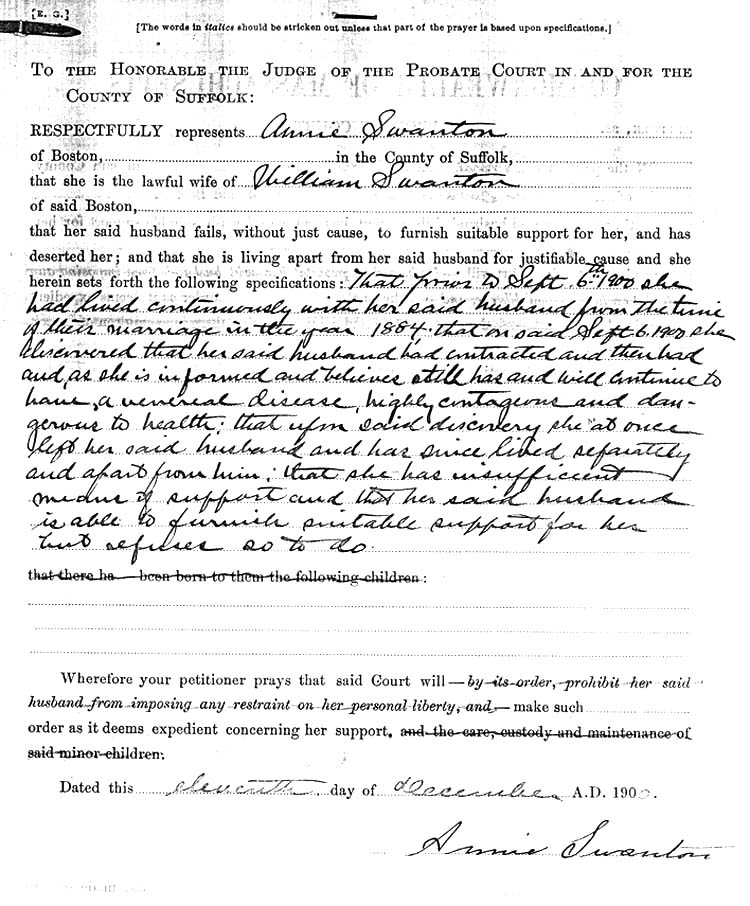
William Swanton, the third son of Michael Swanton and Elizabeth Bradfield, was born in March of 1855 in the townland of Boulteen, County Cork, Ireland. He was baptized on April 5th, 1855 in the Church of the Immaculate Conception in Enniskeane. His baptismal sponsors were Timothy Murphy and Catherine Caniff.
As more of the Swanton family left Ireland, they most likely wrote to their relatives who were still living in Ireland, telling them of the more promising conditions that existed in their new home. William’s brother, John, had left Ireland in 1872, and in 1880, his parents, Michael and Bessie, along with their sons, Robert and James had also emigrated, settling in South Boston, MA.
William immigrated to the United States when he was 27, arriving at the port of New York on May 1, 1882 . He may have traveled with his sisters, Ellen and Martha. William joined his family in Boston, and he lived on South Street.
On October 5, 1884, William Swanton married Anne O’Neil in St. Vincent de Paul Church in Boston. Father G. J. Corcoran, a Catholic priest, performed the ceremony. William was 28 and Annie was 24 when they married. Their marriage witnesses were James Swanton (William’s brother) and Anne O’Neil. Annie’s parents were Peter O’Neill and Ellen Coakley, and she had a sister, Bridget O’Neill. Anne was born in December of 1860 in Cork, Ireland.
As they became more affluent, the Boston Irish gradually moved from South Boston to the outlying suburbs of Dorchester, Jamaica Plain and West Roxbury. From 1886 to 1888, William and Anne Swanton lived at 70 Bromley Street in Dorchester . William was working as a carpenter.
In 1889 and 1890, William and Anne Swanton lived on Weldon Street in Dorchester. In 1990, William purchased a house at 88 Wenham Street in Jamaica Plain, close to Forest Hills Cemetery.
On April 7, 1890 William filed his Declaration of Intent to become a US citizen with the Massachusetts District Court. On September 25, 1901, he became a naturalized citizen of the United States. The witnesses to his naturalization were David J. Gilbert of 54 Weld Hill Street and William M. McDonald of 34 Weld Hill Street. They had known William for six years.
William was successful in business; however, he seems to have had some shortcomings as a husband.
By 1900, William and Annie had been married for 16 years, but had no children. William’s siblings were very prolific, as were most of the Irish Catholic families of the time, implying that there may have been some underlying medical reason for their lack of children. Perhaps Annie’s life would have turned out differently if she had had children.
On June 3, 1900, William Swanton visited a doctor in Newport, Rhode Island for a condition he was obviously trying to conceal, as he didn’t go to a local doctor in Boston. Although Dr. Wheatland diagnosed William’s condition as eczema, he prescribed Fowler’s Solution for it, which was commonly used back then to treat syphilis. William managed to keep his condition a secret from Annie for at least three months, but on September 6, she found out about it and left him. I’m not sure where she moved when she left him—possibly to her sister Bridget’s home. Annie filed for separation support on December 11, 1900.
I would imagine this kind of thing wasn’t publicized or talked about much then, so filing for separation support would have made this a very public incident, undoubtedly causing a lot of embarassment for William.

On December 28, 1900, William Swanton was served with a notice to appear in court to determine whether he should pay Annie separation support. At this time, Annie O’Neil Swanton amended her initial petition and claimed that before she left William, he had ill treated and abused her, was guilty of cruel and abusive treatment toward her, and that he used force and violence against her.
On February 23, 1901, Doctor Marcus Wheatland of Rhode Island was ordered to file a deposition in this separation support case. Dr. Wheatland stated that he had seen William Swanton as a patient twice--first on June 3,1900, and again about one or two weeks later. He testified that he had diagnosed this condition as eczema.
Annie O’Neil Swanton eventually withdrew her petition for separation support, although it isn’t clear whether she moved back in with her husband.
To view copies of the probate record for Annie's separation support in its entirety, click here
On June 22,1909, William Swanton and Annie’s sister, Bridget O’Neil, filed papers with the Suffolk County Probate Court, asking that William be made the legal guardian of Annie, claiming that she was insane.
It’s possible that William had transmitted a venereal disease to Annie. One of the long-term side effects of untreated syphilis is neurosyphilis, which is a slowly progressive and destructive infection of the brain or spinal cord. This can result in mental confusion, depression, uncoordinated movement, and dementia.
Also, in those day, women were often committed for reasons that would seem trivial to us today—melancholia, depression, unwanted pregnancies, or just because they were inconvenient to their husbands. I can’t help but wonder what role Annie’s sister, Bridget, played in all of this.
A letter written on June 18,1909 by Dr. S. W. Crittenden, a physician on the staff of Boston State Hospital, diagnosed Anne Swanton as insane, and stated that she was admitted to the Boston State Hospital in Mattapan on May 21, 1909. Anne was 49 years old at the time.

Annie remained at Boston State Hospital through at least 1921, as William’s records show that he paid $1,988.92 for Ann’s stay there from 1911 to 1921, and $400 for her clothing and washing from 1911-1921.
To view copies of the probate records of Annie's guardianship, click here.
Annie died on October 15,1921. The primary cause of her death was given as diarrhoea and enteritis; the second cause is paranoid condition. Her residence at the time of her death was 1453 Washington Street, Boston, MA, which doesn’t appear to be Boston State Hospital, but also wasn’t the residence of William Swanton.
When Anne died, William filed an Administrator’s Bond to settle her estate. This bond indicated that Anne’s last dwelling place had been 88 Wenham Street, and that her only next of kin were her husband, William Swanton, and her sister, Bridget T. O’Neill, who lived in Canton, MA. This petition asked that William be appointed as administrator of Anne’s estate. Anne’s assets consisted of the following:
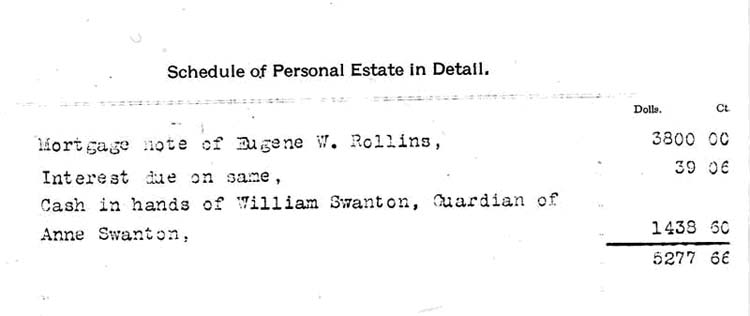
I contacted the Lindemann Health Center, which took over the responsibility for the records of Boston State Hospital, asking them for Anne’s case number and for permission to access and copy her files. Their response was that I would need a court order to access these records. I’m going to try to obtain one, and perhaps we’ll finally be able to learn what really happened.
Annie O’Neill Swanton is buried in Old Calvary Cemetery in the same plot as William’s mother, Bessie Bradfield. William erected a gravestone with both of their names inscribed on it.
However, William’s father, Michael Swanton, died in the Bandon Workhouse in 1890, and until recently, I believed that he died a pauper and was buried in an unmarked grave. I discovered in 2001 that William had sent a sum of money to Father Murphy, the Enniskeane parish priest for the care of his father during his stay in the Bandon Workhouse. Unfortunately, the money arrived too late.
My great aunt, Mary Margaret Swanton Pinkham, remembers visits from her Uncle Will when she was young. He’d give her a quarter, which at that time was a lot of money to a child. Claire and Robert Crowley, the grandchildren of Martha Swanton Crowley (William’s sister) remember Uncle Will doing the same for them. Auntie Mary also remembers that he traveled back and forth from Ireland quite a bit.
Claire Crowley remembers her Uncle Will telling his sister, Martha Swanton Crowley, not to worry—that he would see that she was taken care of in his will. Unfortunately, Martha died before William did, so it would have been a lot better if he had helped her out while they were both still alive.
In 1920, William Swanton lived alone in a triple-decker home, which he owned with no mortgage, at 88 Wenham Street in Jamaica Plain. On the 1920 census record, his marital status was recorded as married.
After Annie’s death, William returned to Ireland. He bought a small cottage known as Seaview in Lislevane, County Cork, where he kept chickens, a few animals, and a garden. His cousin, Kate Bradfield, was his housekeeper.
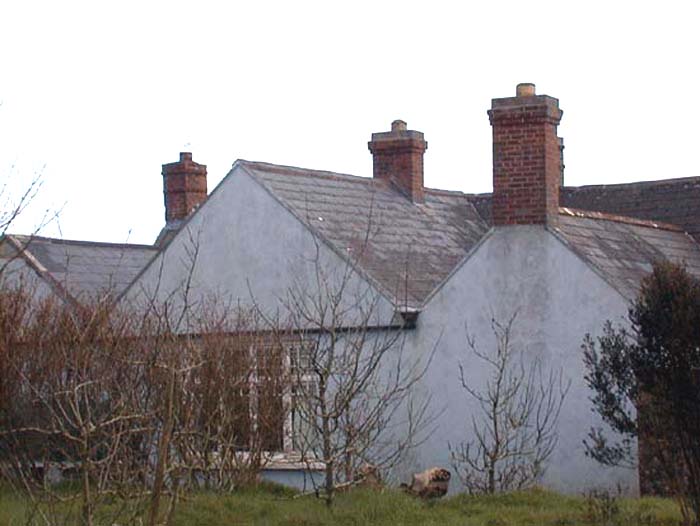
In 1998, I visited Seaview and met Donal and Kathleen McCarthy, who had been neighbors of William Swanton. Donal remembered seeing William once when he was a young boy. Donal had cut through his yard, and William chased him off while brandishing a stick!
Donal McCarthy described Kate Bradfield as a very large woman. She would carry two buckets of milk to the local co-op creamery, one on either side of her, and would take up most of the road. She was also quite a flirt, and was convinced that all the men in the village were after her.
William’s niece, Mary Swanton Pinkham, remembers that her uncle used to travel between Boston and Ireland quite a bit. William sailed from Cobh on the S. S. Baltic on May 11, 1924, arriving at the port of New York on May 19, 1924. On the passenger list, his address in the United States is given as 59 Forest Hill Street, Boston, Mass.
William Swanton died on June 15, 1929 at his home in Lislevane. On the day that he died, William signed a will in which he left everything he owned to Kate Bradfield. This Irish will, however, failed to revoke any previous wills made by William, and the legal tangle this engendered wasn’t settled until 1933.
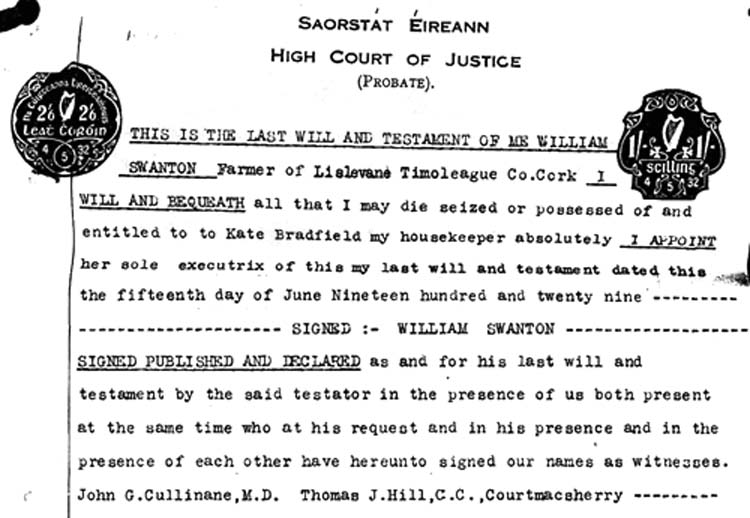
His next-of-kin in American were aghast, as they had always counted on being William’s heirs, based on a will William Swanton had written on July 13, 1928, in which he named Robert Swanton and Leo Crowley as his executors.
The will William wrote in Ireland on the day he died (June 15, 1929) was contested by his heirs in America, led by his nephews Leo D. Crowley (Martha and Michael’s son) and Robert Swanton (Robert and Rosanna’s son).
Robert Swanton died during the litigation from complications of appendicitis in 1931. After Robert’s death, the Swantons felt that they weren’t being fairly represented in this case by the Crowley’s, so there were additional complications among the prospective heirs.
This case eventually went to the High Court of Ireland. Leo Crowley and Kate Bradfield eventually agreed that it was William’s intent that both the American will and the Irish will were both to be in force at the time of his death and were to be regarded as one instrument.
“It is agreed that all assets and property of the deceased situated in the Irish Free State shall be the property of Kate Bradfield and shall be administered by the Irish Executrix (Kate), and that all the assets and property of the deceased situated outside of the Irish Free State shall be the property of the persons named in the American will and shall be administered by the American Executor (Leo) named in said will subject as to the assets in American, in payment of the monies hereinafter provided.”
The outcome of the case was that Kate was allowed to keep the assets and property that William had in Ireland. Each of his 15 heirs in America received $1,174.00, for a total of $17,610.00
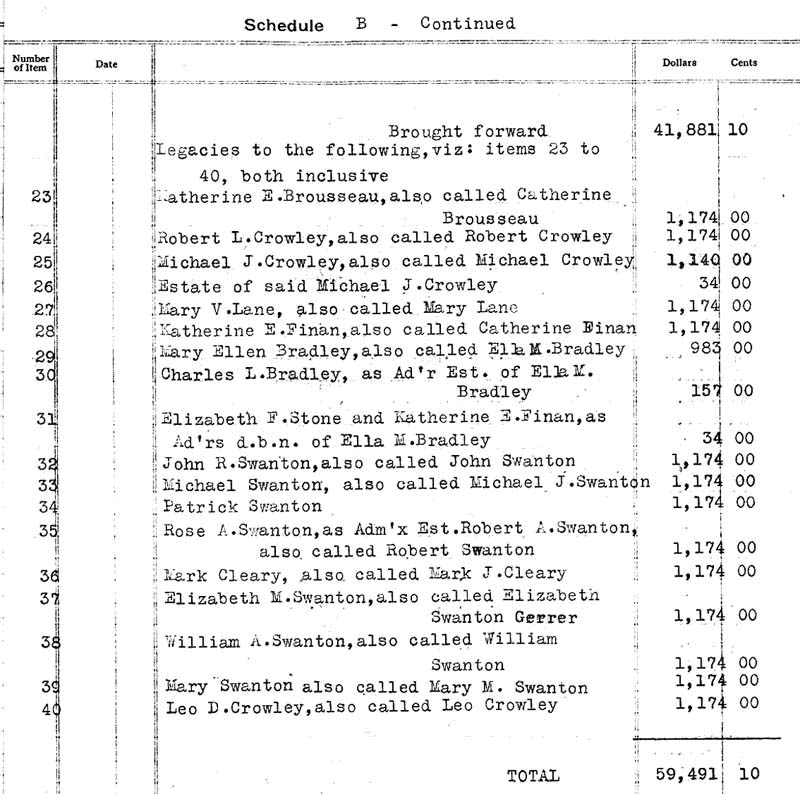
When William Swnton died, he held the mortgages for the homes of Mary C. Flynn and Margaret E. Flynn on Temple Street, West Roxbury. The Swantons who lived in Garranekinnefeake, Ireland, were closely affiliated with the Flynn family, so perhaps this indicates a connection with this Swanton branch.
William was buried in the old Murragh Cemetery outside of Enniskeane, probably in the Bradfield plot. I wasn’t able to find a gravestone for him there.
Kate remained at Seaview in Lislevane until her death. She left the house to Richard Bradfield, the father of Tommy Bradfield, late of Enniskeane (died October 17, 2001). However, there was a dispute about it, as Richard wasn’t a first cousin, and the house eventually went to Kate’s first cousins, the Hosfords.
Denis Mahony, the undertaker in Enniskeane remembers burying Kate Bradfield in the Old Murragh Cemetary. She was one of the last people to be buried there.
Click here to see William Swanton's will in its entirety.